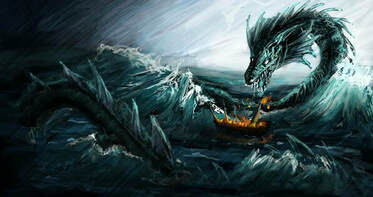Forneus; Earth's Mystery Sea Monster
By James Donahue
Aaron Donahue's evocation of the Goetian Spirit Forneus and the subsequent remote viewing session with it in a private temple with him was no doubt a memorable experience. This beast, said Aaron, was a giant, hovering over him from behind.
Donahue sensed it as a "tall formless shadow" that he said moved "no further than the corner view of the temple where the evocation has taken place. It is held within the circle and begins to 'speak' as I remote view."
He added that this shadow "appears to be related to a plasma like figure that is speaking a language that I do not recognize."
As his hands quickly sketched the form of Forneus, Donahue was surprised to find it a giant, almost shapeless form with a large hole near the top where a face, had it been a worldly creature, should have been.
As I began to research the things known about this beast, something interesting emerged.
"Forneus appears as a great monster of the sea 30 feet long and six feet in diameter," said one description. "His scales are precious stones, his eyes are like fire and the flesh of drowned sailors clings to his teeth."
S. L. MacGregor Mathers agrees that Forneus "appears as a great sea monster."
In fact, the old magicians referred to Forneus as the Marquis of the Waters, saying that the seas are his natural home.
With this in mind, and looking at Aaron's drawing once more I was reminded of the famous photograph of the monster of Loch Ness, with only its head and "neck" showing out of the water. It was assumed that the rest of this beast was attached and under the water. But was this necessarily true?
It is interesting to note that Scottish legend has it that the Loch Ness monster has only one eye.
And what about the stories told by the old salts on sailing ships of old, who brought home tales of great sea monsters thrusting their ugly heads up over the sides of their vessels.
Could it have been that these visions were all glimpses of the Spirit Forneus? Did someone accidentally summon this powerful entity, or was he simply making a "friendly call" to a lonely ship passing on the great expanse of a seemly endless sea?
Whatever the reason for his calling, Forneus probably was probably not a threat. Johann Wier, in his Pseudomonarchia daemonum of 1587, says he believes evoking this spirit only brings good fortune.
"He maketh men woondeffull in rhetorike, he adorneth a man with a good name, and the knowledge of (tongues), and maketh one beloved as well of foes as freends," Wier wrote in early English text.
By James Donahue
Aaron Donahue's evocation of the Goetian Spirit Forneus and the subsequent remote viewing session with it in a private temple with him was no doubt a memorable experience. This beast, said Aaron, was a giant, hovering over him from behind.
Donahue sensed it as a "tall formless shadow" that he said moved "no further than the corner view of the temple where the evocation has taken place. It is held within the circle and begins to 'speak' as I remote view."
He added that this shadow "appears to be related to a plasma like figure that is speaking a language that I do not recognize."
As his hands quickly sketched the form of Forneus, Donahue was surprised to find it a giant, almost shapeless form with a large hole near the top where a face, had it been a worldly creature, should have been.
As I began to research the things known about this beast, something interesting emerged.
"Forneus appears as a great monster of the sea 30 feet long and six feet in diameter," said one description. "His scales are precious stones, his eyes are like fire and the flesh of drowned sailors clings to his teeth."
S. L. MacGregor Mathers agrees that Forneus "appears as a great sea monster."
In fact, the old magicians referred to Forneus as the Marquis of the Waters, saying that the seas are his natural home.
With this in mind, and looking at Aaron's drawing once more I was reminded of the famous photograph of the monster of Loch Ness, with only its head and "neck" showing out of the water. It was assumed that the rest of this beast was attached and under the water. But was this necessarily true?
It is interesting to note that Scottish legend has it that the Loch Ness monster has only one eye.
And what about the stories told by the old salts on sailing ships of old, who brought home tales of great sea monsters thrusting their ugly heads up over the sides of their vessels.
Could it have been that these visions were all glimpses of the Spirit Forneus? Did someone accidentally summon this powerful entity, or was he simply making a "friendly call" to a lonely ship passing on the great expanse of a seemly endless sea?
Whatever the reason for his calling, Forneus probably was probably not a threat. Johann Wier, in his Pseudomonarchia daemonum of 1587, says he believes evoking this spirit only brings good fortune.
"He maketh men woondeffull in rhetorike, he adorneth a man with a good name, and the knowledge of (tongues), and maketh one beloved as well of foes as freends," Wier wrote in early English text.

